Introduction
During the COVID-19 pandemic, health authorities and governments around the world implemented emergency and unprecedented measures to prevent coronavirus dissemination. The effect of these measures on particular aspects of people’s lives such as sexual and reproductive health outcomes has been given less attention, in scientific debates, even though they may reflect both the impact of the epidemic on health systems and indirect issues involving multiple, and different sources mainly in low and middle-income countries 1. For example, a narrative review focusing on legal abortion care in Latin American countries reported that the COVID-19 pandemic affected sexual and reproductive services, and underscored the need to measure its impact on access to health services and further identify the most affected groups 2.
According to the Pan American Health Organization (PAHO), the direct consequences of COVID-19 are related to the physiopathological interactions between coronavirus and the human body 3. The indirect consequences are defined as those that people experience in times of crisis or emergency situations including restrictions on movement, disruption of health service provision, and socioeconomic issues 3.
School closure was one of the most dramatic measures implemented in almost all countries of the world to prevent COVID-19 transmission 4. A review of evidence based on past pandemics showed that school closure may affect child and adolescent life, leading to undesirable incidents such as child labor, early marriage, adolescent pregnancy, and harmful practices and violence 5.
In a mixed-methodology study, authors indicated that adolescents have fewer obligations in times of school closure, and therefore they have more free time to spend with their partners, increasing the chances of cohabitation, marriage, and early pregnancy 6. Approximately 50% of the pregnant adolescents aged 15-19 years in low-middle income countries in 2019 had an unintended pregnancy. Six out of 10 of all unintended pregnancies ended in induced abortions 7.
In Brazil, schools were fully closed in mid-March (2020), leaving more than 52 million (26 million women) students at home, and gradually reopened in 2021 8. Considering this worrisome scenario, it is crucial to expand the knowledge regarding the possible effects that followed the measure implemented, especially in vulnerable populations.
Literature regarding reproductive data from under 15 girls is scarce 9 and restricted to fertility rates which suggest values of 3.29 per 1,000 births in Brazil, 10. In the USA, analysis of disparities in abortion rates indicated that women of color have higher rates of abortion than white women 11. Our assumption is that the indicators of reproductive health worsened during the pandemic in 2020, and this differentially affected white and non-white adolescents. Thus, we implemented this study focusing on the frequency of abortion that required hospital admissions in order to better understand the effect of the school closure in 2020, on female sexual and reproductive health. In addition, the results of this study could help mitigate future unfavorable outcomes involving adolescents in times of crisis.
We tested two different hypotheses: (i) that hospitalizations of 10- to 14-year-old girls due to abortion rose during the COVID-19 epidemic in Brazil and (ii) that the trends in hospitalization differed by skin color. The objective was to compare the monthly hospital admission rates due to abortion before and during school closure.
Methods
Study Design and Setting
This ecological study was carried out using interrupted time series (ITS), a quasi-experimental design that is suited to evaluate public health interventions 12. We used hospital admission statistics from a nationwide database managed by the Department of Informatics of the Unified Health System (DATASUS) from the Ministry of Health, Brazil 13. Brazil is an upper middle-income country in Latin America and the Caribbean region, having an estimated population of 210,755,692 inhabitants according to data retrieved on July 1, 2019. Of the total population in Brazil, more than 7 million accounted for women aged 10-14 years old (7,343,636).
Intervention and Time Frame
The intervention was the school closure which took place in March 2020. Under normal conditions, the Brazilian school calendar runs from February (private school) or March (public school) to December, intercepted by a short holiday break, in July. However, in March 2020, Brazilian face-to-face class activities were halted to prevent the spread of coronavirus infection, and the situation remained unchanged at least until December 2020. Using the beginning of school closures in Brazil (March 2020) as a point of reference, we defined the pre-intervention (January 2019 to February 2020) and the post-intervention (March to December 2020) periods.
Data Source
Number of Hospitalizations
The information regarding the number of hospitalizations due to abortions was retrieved from the Hospital Information System (SIH-SUS), a subsystem coordinated by DATASUS, which manages health data for 80% of the Brazilian population. We selected hospital admissions that were registered as “other pregnancy with abortive outcomes,” “spontaneous abortion,” and “medical abortion.” The monthly number of abortion hospitalizations of girls aged 10-14 years old was retrieved focusing on the period from January (2019) to December (2020), in concert with information regarding ethnicity/skin color in accordance with the Brazilian Institute of Geography and Statistics (IBGE) 14. Information was collected from the DATASUS website during January 2022. The skin color categories used in DATASUS are based on the IBGE classification (white, black, yellow/East Asian ancestry, indigenous, brown/mixed ethnicity). The cases classified as ignored were proportionally redistributed among the five different types of skin color, thereby avoiding the loss of information.
Population Data
The monthly population was calculated using the geometric method which has an assumption that the population grows proportionally according to a constant (r coefficient) obtained as indicated below (Equation 1 and Equation 2), where P0 is the expected population for 10- to 14-year-old girls on July 1, 2019, and Pt is the expected population for 10- to 14-year-old girls on July 1, 2020, which were projected by IBGE.
Equation 1 was used to obtain r coefficient: r = [Pt/P0][1/(t−0)] −1, t being the number of months from July 1, 2019, to July 1, 2020. Equation 2 was used to obtain the projected population: Pt = P0[(1 + r)(1/(t)], t being the n time points that need to be projected. After performing the above calculation, we then used ethnicity/skin color distribution data from the 2010-Brazilian Census (IBGE) to redistribute the population of females aged 10-14 years according to ethnicity/skin color strata.
Data Analysis
Hospitalization Rates
The hospitalization rates were estimated for each month of the study period according to skin color strata: (i) all girls, (ii) white girls only, and (iii) non-white girls only, and this group included black and brown/mixed color girls. We performed estimates for Brazil as a whole and the rates were presented as per 100,000 person-month.
Interrupted Time Series
The ITS models were implemented via segmented regression and generalized least square approach in RStudio (version: 4.0.3) 15. The assessment of the effect of homeschooling or keeping children without attending schools, on the number of hospital abortion admissions was performed by checking the parameters over the 10 months during intervention in comparison to the previous 14 months preceding the intervention. We estimated exploratory models considering the independence of data, and more robust models specified to control potential lagged influences (corrected by the insertion of n serial autocorrelation terms). The generalized least squares approach allows to specify models fitted for n autoregressive terms. Serial autocorrelations were assessed via the Durbin-Watson statistics with a p value <0.05 suggesting autocorrelated residuals 16, and by inspecting autocorrelation function and partial autocorrelation function graphs (see online suppl. material I; for all online suppl. material, see https://doi.org/10.1159/000535227). The models were corrected for n lags pointed out through autocorrelation analysis considering parsimony and Akaike information criteria.
Absolute and Relative Changing
To estimate predicted and counterfactual values, we adapted the method used by Wagner et al. 17. We used the parameters β0 (preexisting level), β1 (preexisting trend), β2 (level changing), and β3 (trend changing) provided by ITS analysis with one intervention only and two equations (Equation 1 and Equation 2). Equation 1 and Equation 2 are shown below, where Yi is a monthly rate of hospitalization, “time” is time in months since the start of the study period, “level” is the change that happens immediately following the intervention, “trend” is the change that happens gradually over the study period after the intervention.
Absolute changing indicates whether the changes are increasing or decreasing at a given time point, while relative changing provides the same but as a percentage value. Using the results obtained from the abovementioned equations, and taking into consideration the estimates of specific months, the absolute changing and relative changing for a given time point were calculated using the formulas:
Absolute changing = predicted values − counterfactual values
Relative changing =[(predicted counterfactual values)/(counterfactual values)] × 100
Sensitivity Analysis
Since the variable “skin color” might reflect some degree of female misclassification across the different strata, we implemented ITS analysis that clustered the groupings white and non-white girls together, besides the initial proposal to analyze the white girls separated from non-white girls. Additionally, by considering that the adverse outcome of abortion could result from host-pathogen interactions involving coronavirus infection, we also explored the possibility of some level changing or trend changing having occurred in adult women of non-mandatory school age (30-34 years).
Results
From January 2019 to December 2020, there were 3,328 hospital admissions due to abortions in females aged 10-14 years, reaching the monthly average of 139 during the same period. The calculated means for hospitalization before and during school closure were 142 and 134 over pre-intervention and post-intervention periods, respectively. Hospital admissions dropped during the first 4 months of school closure and reached the lowest level in July 2020, which registered 106 hospital admissions. However, the number of hospitalizations later increased and the highest number was registered in November 2020 (n = 173).
Non-white teenagers recorded the highest hospitalization rates with monthly values above 2 per 100,000 person-month. This group recorded abortion rates as high as 3.29 and 3.22 per 100,000 person-month in October and November 2020, respectively. By matching the monthly abortion admission rates, the smallest and largest differences between non-white and white girls were found in September 2019 (2.14 times) and in October 2020 (6.79 times), respectively (Fig. 1).
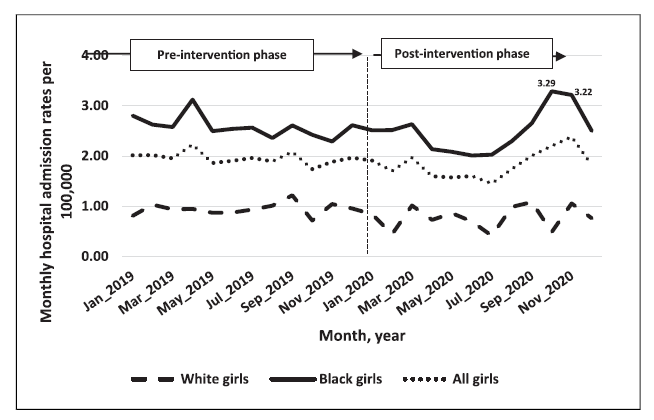
Fig. 1 Historical series of monthly hospital admission rates due to abortion in girls aged 10-14 years in Brazil between January 2019 and December 2020.
The ITS analysis revealed that there was no statistically significant difference in level changing immediately after school closure in any population strata. However, statistically significant positive coefficients were detected for post-intervention trend changing both in the total population (coefficient: 0.07; 95% confidence interval [CI]: 0.02; 0.11) and the non-white population (coefficient: 0.07; 95% CI: 0.03; 0.11), thus indicating an average increase in monthly hospital admission rates over the post-intervention period compared to baseline pre-intervention estimates. The ITS analysis did not detect statistically significant trend changes (coefficient: 0.02; 95% CI: −0.01; 0.05) in hospital admission rates due to abortion in the white population under study (Table 1).
Table 1 Effect of school closure on hospital admissions due to abortions among girls aged 10-14 years during COVID-19 pandemic in Brazil
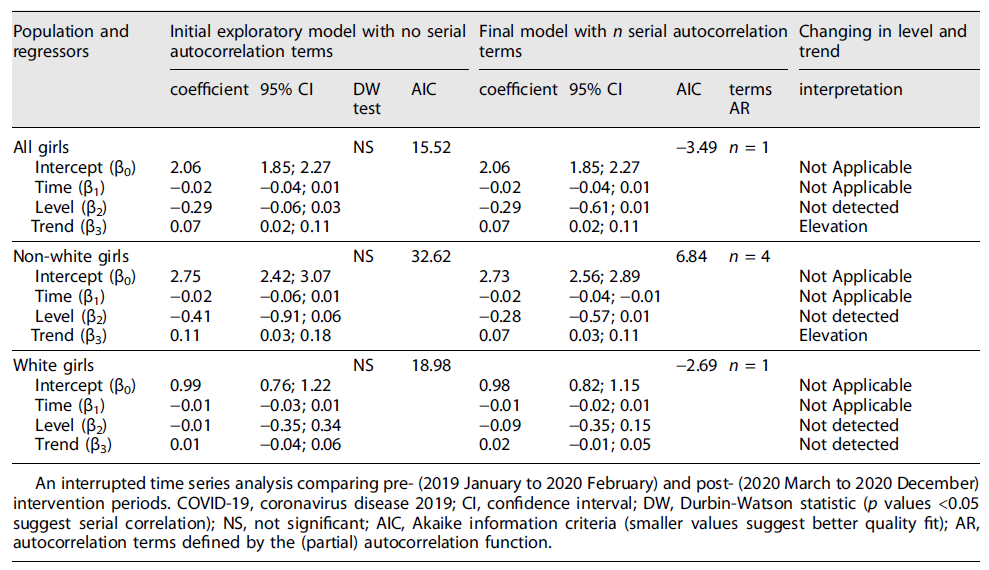
Our results can be visually assessed by examining the observed, counterfactual, and fitted estimates displayed in the graphs (Fig. 2-4). Using a sufficient number of pre- (n = 14) and during the intervention (n = 10) months with rates linearly arranged, this study detected the lowest hospital admission rates for five successive months (April to August 2020) during the intervention period in the total population (Fig. 2) as well as the non-white girl population (Fig. 3). The highest abortion admission rate among white girls occurred in September 2019 (1.22 per 100,000), but the school closure did not have an effect on abortion hospitalizations among these girls (Fig. 4).
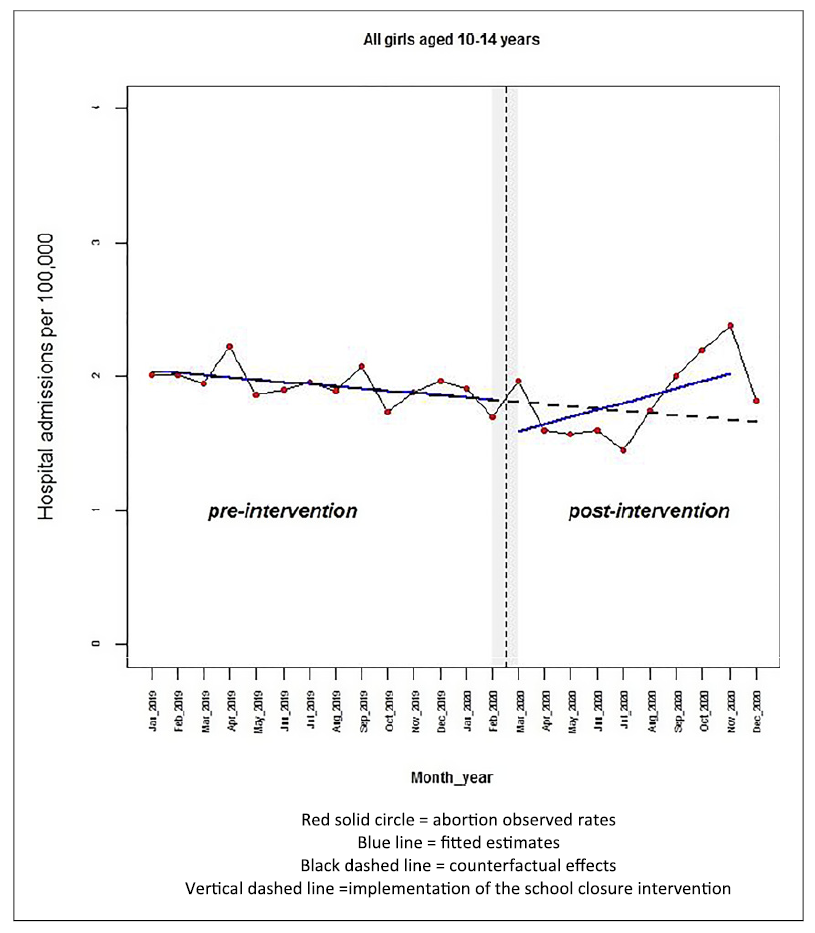
Fig. 2 Monthly hospital admission rates due to abortion in all girls aged 10-14 years: comparison between pre-intervention period (Jan 2019 to Feb 2020) and post-intervention period (Mar 2020 to Dec 2020) in Brazil.
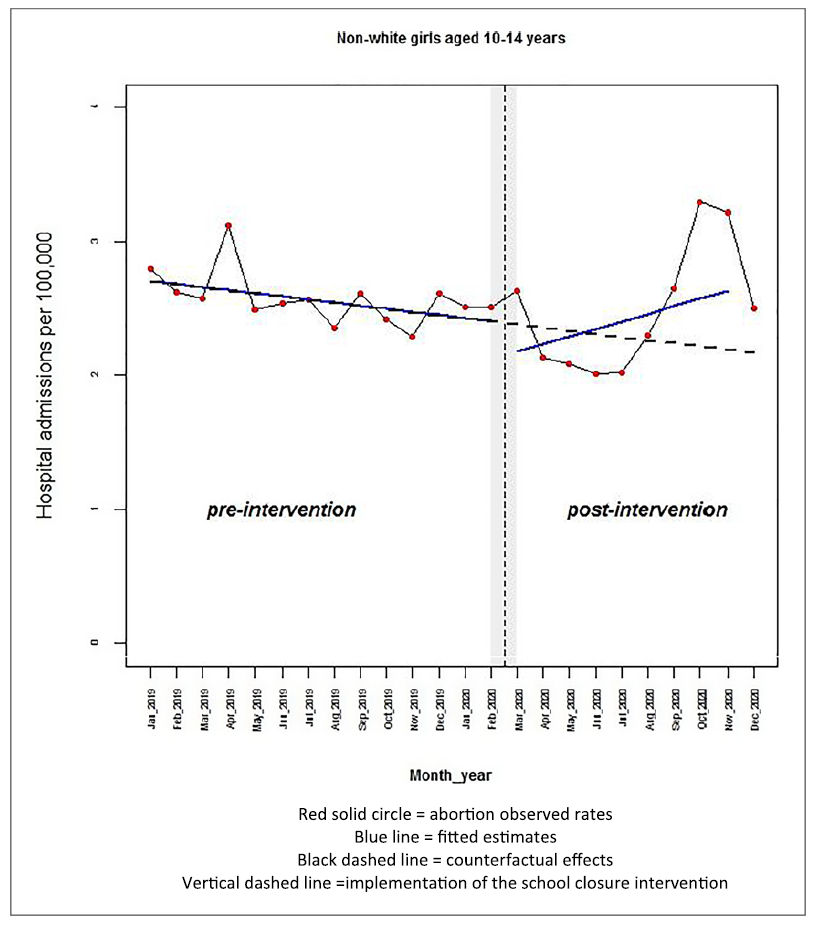
Fig. 3 Monthly hospital admission rates due to abortion in non-white girls aged 10-14 years: comparison between pre-intervention period (Jan 2019 to Feb 2020) and post-intervention period (Mar 2020 to Dec 2020) in Brazil.
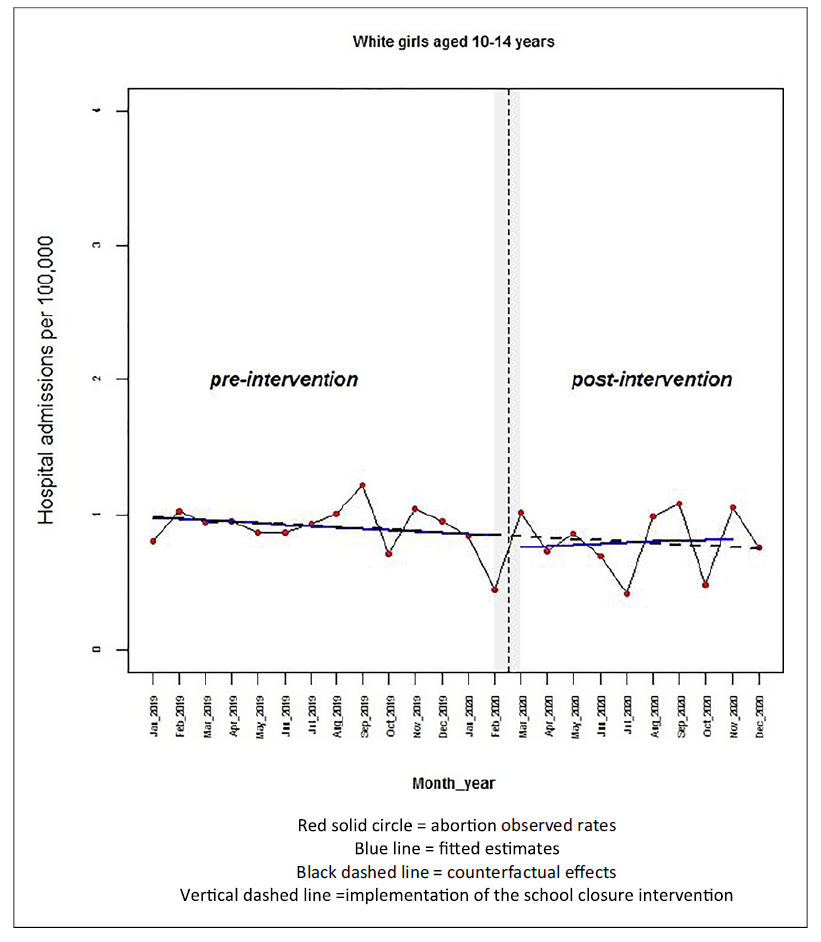
Fig. 4 Monthly hospital admission rates due to abortion in white girls aged 10-14 years: comparison between pre-intervention period (Jan 2019 to Feb 2020) and post-intervention period (Mar 2020 to Dec 2020) in Brazil.
After estimating the predicted and counterfactual values, we calculated the absolute and relative changing values. For example, our results showed that in November 2020 the fitted rates for the girl population as a whole (2.02 vs. 1.68 per 100,000), the non-white girls (2.62 vs. 2.20 per 100,000), and the white girls (0.82 vs. 0.76 per 100,000) were 20.38%, 20.00%, and 8.00% higher than the counterfactual rates, respectively.
Sensitivity Analysis
In addition, we implemented a sensitivity analysis. Since both random and systematic errors have determined possible misclassification of skin color, we performed an ITS analysis on the white and non-white female populations together. The ITS model was specified with four parameters of serial autocorrelation and revealed statistically significant effects over the post-intervention period, suggesting the occurrence of both a negative and immediate level change (coefficient: −0.31; 95% CI: −0.50; −0.12) and an increasing trend changing (coefficient: 0.06; 95% CI: 0.04; 0.09), even aggregating two large and differentiated population groups. We also examined hospitalizations due to abortions in adult women from non-mandatory school age (30-34 years old) in Brazil. None of the adjusted models revealed statistically significant trends comparing the post- and pre-intervention rates estimated for the total adult women (30-34 years) under study (trend changing: −0.15; p value: 0.681), white adult women (trend changing: 0.19; p value: 0.442), and non-white adult women (trend changing: 0.35; p value: 0.584).
Finally, we checked if the school holidays determined some additional effect on the abortion admissions by running ITS models for the holiday in July (ITS_holiday_1) and the holiday in January, February, and July (ITS_holiday_2). The white girls were the only group that presented a statistically significant range, indicating a reduction in hospitalizations that occurred before and during the pandemic months. The following coefficients were obtained: coefficient −0.186 and p value 0.1864 for ITS_holiday_1 in white girls and coefficient −0.203 and p value 0.0106 for ITS_holiday_2 in white girls. ITS_holiday_1 in non-white girls revealed a coefficient of −0.024 and p value 0.8479, and ITS_holiday_2 in non-white girls had a coefficient of −0.026 and p value 0.8014, ITS_holiday_1 in all girls revealed coefficient −0.237 and p value 0.0982, and ITS_holiday_2 in all girls had coefficient −0.107 and p value 0.2613.
Discussion
The ITS results showed that hospitalization rates due to abortions not only increased among 10- to 14-year-old girls during the COVID-19 epidemic in 2020 but also negatively differentially impacted non-white girls than white girls. These results provide insights into the possible effects of the measures to curb coronavirus transmission that were implemented, specifically the closing of schools which was the hypothesis of this study. FULCHER et al. 18 reported similar results from a study conducted in Massachusetts (USA) where legal abortion services are offered. Young adult women and adult women experienced a lower than expected number of abortions from March 2020. The number of minors was close to the expected number until June and shifted to lower than expected in July until October and returned to the expected by November 18. A study in Italy indicated that requests made by teenagers to obtain induced abortion increased from 6.1% (pre-COVID-19 phase) to 9.5% (COVID-19 phase) and occurred in higher numbers in later gestational ages. A fraction (3.4%) of the adolescents stated that the gestation was a consequence of the rape 19.
On 26th February (2020), the first case of coronavirus infection was reported in Brazil which led to the implementation of several emergency measures to control the coronavirus outbreak, including school closures that started on 16th March (2020) 20. Thus, millions of Brazilian students transitioned from face-to-face learning to remote learning under the “quarantine guidelines” until the end of the year 2020. The possibility that the non-white girl population complied with government recommendations regarding staying at home and seeking medical care only in cases of extreme need may have determined the magnitude and trend rates. The drop in rates observed 2 months after the intervention, followed by a sharp increase in August, strengthens the interpretation that there was a decrease in the access to and use of routine health services due to COVID-19. On the other hand, since schools are places of learning and empowerment, interrupted access to education puts adolescents at risk for early marriage, domestic abuse, early pregnancies, and potentially serious consequences, especially among vulnerable populations (4). The experience extracted from this study can direct lessons and alternatives to mitigate similar and future situations.
School closure was among the most critical measures implemented, fully or partially in some countries. Scientific analysis on whether the advantages of school closure outweigh the disadvantages in preventing the spread of the coronavirus is ongoing, making the evaluation of indicators of child and adolescent health critical to understanding other specific effects of school closure 21. According to World Vision (2020) on the COVID-19 Aftershocks, school closures in times of crisis can result in longer free time, and young females could spend more time on their relationships with the opposite sex than they would if they were in school 22. In this sense, sexual and reproductive health must be prioritized because sexual discovery and engagement in affective and sexual relationships happen naturally throughout adolescence. Thus, it is important to consider that unintended teenage pregnancies may result in prolonged school closures 23.
Teenage pregnancy is a reality in developing countries as evidenced by at least 777,000 yearly births among young females under 15 years. In addition, approximately 5.6 million pregnancies are terminated (aborted) in 15- to 19-year-old adolescents 24. Our study showed that a fraction of the young girls that became pregnant during the COVID-19 pandemic in Brazil sought hospital admissions for abortion healthcare, and recorded rates higher than the pre-pandemic year (2019). This observation is perhaps the tip of the iceberg in that other important issues affecting minorities that are usually omitted may have been maximized by the COVID-19 pandemic. These issues may include sexual exploitation, early marriage, economic stress, lack of access to contraceptive methods and sexual education, death of a caregiver, loss of family care due to hospitalization or quarantine, domestic violence, and poverty, all of which require effective political actions synchronously contextualized in times of crisis 25. The ITS results suggested that the females who were hospitalized due to abortions could have experienced better reproductive outcomes if the emergency measures implemented in the first 10 months of the COVID-19 pandemic in Brazil did not include school closure, that is the disruption of face-to-face classes, or had provided more adequate support in the context of reproductive health.
This study has some limitations. First, given the simultaneous and universal feature of the school closure intervention in Brazil, we did not have a similar female-aged control group to perform robust comparisons. To circumvent this limitation, we performed an ITS analysis of hospital abortion rates in adult women from the non-mandatory school age, of which no evidence of trend changing was revealed when comparing the pre-intervention and post-intervention periods, thereby strengthening our assumptions. Second, skin color is a self-declared feature in Brazil, making it prone to misclassification. Hence, we analyzed the 10- to 14-year female population as a whole and the results demonstrated a similar trend to that of the non-white. Lastly, since SIH-SUS covers more than 80% of the Brazilian population, the remaining 20% belong to the most affluent portion and thus utilize private health insurance, leading to the possibility that abortions that arose from this group were not captured by this study, thereby introducing a selection bias. In view of these limitations, our results should be interpreted with caution, until new studies provide more robust responses to these issues.
On the other hand, we analyzed an intervention (school closure) which was implemented nationally at the same time frame allowing a clear definition of the pre- and post-intervention periods. We included enough time points; pre-intervention (14 points) and post-intervention (10 points), making both the statistical analysis and the result interpretation more robust. Besides this, considering that the evidence of association between the COVID-19 vaccination and spontaneous abortion is still ongoing 26,27, our study may be considered free from any effect confounded by COVID-19 vaccine programs because none of them were being offered in Brazil in 2020.
Randomized controlled trials could provide the best evidence about public policies that are ongoing in this time of the pandemic, but they would not be ethical or viable mainly on a large scale as would be required in some situations 28. In this sense, ITS analysis can provide clear and important insight into the effectiveness of population interventions 8. Having comparator groups, a sufficient number of time points and implementing adjusting statistical analysis, including terms of serial autocorrelations are ways to aggregate robustness and validity, and therefore generate good quality evidence to guide health decisions 28.
Conclusion
This study showed that the hospitalizations in Brazil due to abortions in 10- to 14-year-old girls increased during the COVID-19 pandemic in 2020. The number of abortions was higher in the non-white population than in the white population. Furthermore, recognizing that the implementation of school closure affected the minority population differentially can help develop more effective actions to face future similar situations.
Acknowledgments
The authors of this study would like to thank the Unified Health System (SUS) for publicly providing the data used in this study.
Statement of Ethics
This study was conducted using deidentified secondary data publicly provided by DATASUS and was in compliance with Resolution 466/2012 of the National Health Council. In addition, the study was approved by the Research Ethics Committee on April 21, 2021, and allocated the registration number 4.663.005.
Author Contributions
Maria Isabel do Nascimento, Thalys Gabriel Rabelo Silva, Victor Joshua de Aguiar Mello Nascimento, and Luis Patricio Ortiz Flores, Billy McBenedict contributed to the conceptualization, design, analysis of data, interpretation of results, and writing of the draft. All authors read and approved the final manuscript version as submitted and are responsible for its content.
Data Availability Statement
The data that support the findings of this study are publicly available on the Unified Health System website (http://tabnet.datasus.gov.br/cgi/deftohtm.exe?sih/cnv/nruf.def), of which the specific information that was extracted can be presented upon request from author 5 (corresponding author).
















